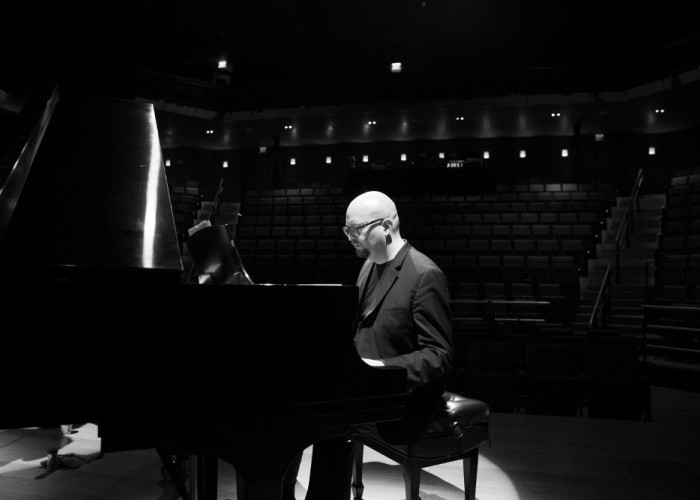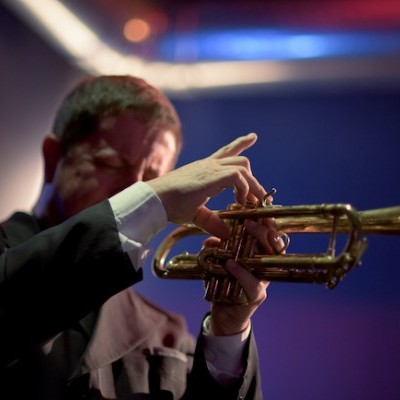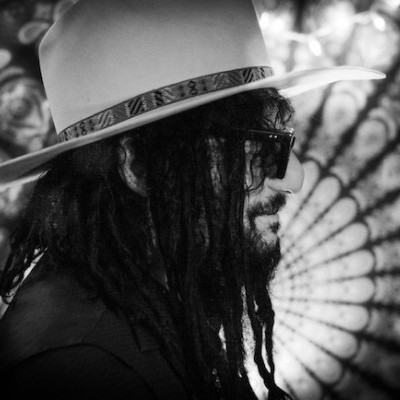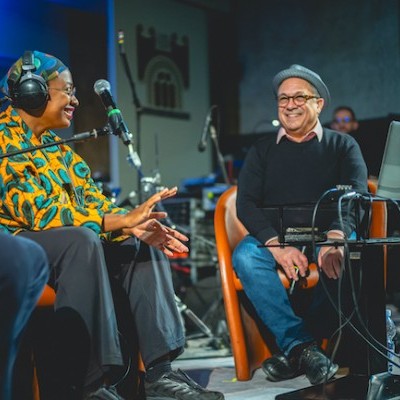Jul 9, 2024 11:35 AM
Trumpeter, Educator Jim Rotondi Dies at 61
Jim Rotondi, a renowned hard-bop trumpeter, composer and educator, died suddenly on July 7 at a hospital in France. He…

Pianist Ethan Iverson collaborates with saxophonist Mark Turner on Temporary Kings.
(Photo: Robert Lewis)Midway into his career, pianist Ethan Iverson has experienced a universe of multifaceted artistry and in many collegial opinions has become a restless visionary.
Iverson continues to evolve as a deep, enlightened, good-humored artist who has excelled in a variety of musical settings—from composing formal classical scores, to being the musical composer/arranger for choreographer Mark Morris, to breaking jazz rules in The Bad Plus (the trio he co-founded in 2000 and departed from in 2017). Iverson also teaches at New England Conservatory, where he’s been on faculty since 2016. And he has gained considerable esteem as a prose writer, thanks to his contributions to The New Yorker and his widely read blog, Do the Math.
Iverson stands as a passionate dynamo at the crossroads of jazz and classical music. “To move the music forward, you have to think about the greatest jazz and the greatest classical music,” he said in his Brooklyn apartment, seated in front of a large painting by his father depicting the house in which he grew up, during formative years spent near the border of Minnesota and Wisconsin. “In back-to-back weekends recently, I got to play duos with Ron Carter, whose tradition I feel myself in, and Miranda Cuckson, one of the best new music violinists in New York, who is also part of my tradition. I was watering my garden in an unbelievable way with these two heavyweights.”
Iverson’s new album is Temporary Kings (ECM), a remarkable duo project with tenor saxophonist Mark Turner. On the recording, the pair dives into a conversational, chamber-jazz setting with mysteries, musings and motif-bending originals (six by Iverson, two by Turner). They give a nod to the Lennie Tristano-Warne Marsh school of cool with a playful flight through Marsh’s “Dixie’s Dilemma” (which is based on the changes to Jerome Kern’s “All The Things You Are”). The two artists have a long history of collaboration. Most notably, they served as the solo powerhouses in drummer Billy Hart’s quartet with bassist Ben Street starting in 2005, later appearing on Hart’s ECM albums All Our Reasons (2012) and One Is The Other (2014).
In a recent phone conversation, Turner said that the duo album is rooted in the Hart connection. “One thing was clear to Ethan and me in wanting to play with Billy was an interest in older music, traditional music, folklore, and how that informs the music of the present,” he said. “Billy exemplifies that—the modern and the present. He embodies what we want to be. Ethan brought up the idea to do this album. There wasn’t any back-and-forth. It’s just a continuation of our relationship within Billy’s band.”
Temporary Kings was recorded last year at the RSI studio in Lugano, Switzerland. “It’s fun to play free with Mark, because he has perfect pitch; he can hear what I’m doing.” Iverson said. “I don’t have perfect pitch. But his mind is so acute, he can always do things that are a little less obvious, whereas I can be too obvious, because I’m seeking clarity.” He paused and added, “I’m willing to sacrifice jazz hipness for clarity.”
On the asymmetrical title track—named after the 1973 novel in Anthony Powell’s 12-volume epic, A Dance To The Music Of Time—Turner sings while Iverson swoops to create flow and sonic power. Iverson said that the book metaphorically nods to the old days when there were kings who served for a brief period and then, at the end of their reigns, were executed. “It’s like our time recording in Lugano,” he said. “We record in this fancy studio with [ECM’s] Manfred Eicher, and then we come back to Brooklyn. Mark’s taking his kids to school, and I’m playing for a dance class. So, we were temporary kings.”
Key to the success of the recording sessions was the artists’ mutual admiration. “I have tremendous respect for Mark in every dimension,” Iverson explained. “I listen to Mark, not just musically, but what he says to me as a person. It’s like when he told me that it takes us longer to be great now because there is so much more to learn. Mark is a very gentle Buddhist and family man. He plays the best tenor saxophone of his generation, and he’s not doing it in an aggressive way. He doesn’t care about commercial success and doesn’t put a package together to make himself famous. It’s really an honor to play with someone who has that level of purity.”
“Ethan is iconic,” Turner said. “There’s no one like him. He’s a true individual. The main thing he has is his touch, and I like his comping, especially with his note choices and voicings.”
Iverson took piano lessons up to the 7th grade, but decided to quit when he became concerned that he wouldn’t ultimately get to his passion: jazz by the likes of Count Basie and Thelonious Monk. “I could read music very well,” he said, then laughed. “In fact, I’m a famous sight-reader today. But I got this message that a teacher wasn’t going to help me with jazz. In fact, maybe it could harm me. It’s like the Mary Lou Williams jazz tree, where she says that classical studies don’t help. There are many verdant branches on the tree, but the classical branch, with its études and books, is a dead branch. Paul Bley said that if you go too far down the classical path, you won’t figure out how to play jazz. The irony is that no one knew more about European classical music than he did, and I have become pretty expert at it, too.”
Iverson enrolled at New York University in 1991 to study jazz, but he only lasted two years. Among his instructors was Jim McNeely. “The most important part of [McNeely’s] classes was when he told stories about playing with Sonny Stitt and Thad Jones and others,” Iverson said. “I know he showed me some stuff on the piano, but I think the essence of jazz is in those stories. That’s the way I think jazz works as a curriculum.”
Iverson went on to take private lessons with Fred Hersch, who sent him to classical teacher Sophia Rosoff and her colleague Robert Helps (1928–2001). Today, he studies with John Bloomfield.

Jim Rotondi was acclaimed for his wide, round trumpet tone, remarkable virtuosity and assured swing.
Jul 9, 2024 11:35 AM
Jim Rotondi, a renowned hard-bop trumpeter, composer and educator, died suddenly on July 7 at a hospital in France. He…

Charles Lloyd, seen here at the 2024 New Orleans Jazz & Heritage Festival, makes DownBeat Poll history!
Jul 11, 2024 12:23 PM
The incomparable Charles Lloyd swept the 72nd Annual DownBeat Critics Poll, becoming the first artist ever to earn…

“Being president of Blue Note has been one of the coolest things that ever happened to me,” Was said. “It’s a gas to serve as one of the caretakers of that legacy.”
Jun 4, 2024 12:21 PM
Sitting with Don Was is a comfortable and unhurried exercise. He may seem slightly reserved at first, but ideas and…

“She reminds me of my childhood and makes we want to cry,” Cécile McLorin Salvant, pictured here with writer Ashley Kahn, said of Dianne Reeves.
Jun 11, 2024 12:31 PM
Italy’s Umbria Jazz Winter is one of those rare annual festivals that not only coincides with a major holiday —…

Maria Schneider said of Decades, her new compilation release: “I just wanted to create something, put it in a beautiful box and say, ‘Look at what we did.‘”
Jun 18, 2024 12:00 PM
Maria Schneider opened the sleek black box and placed it on a coffee table in her Manhattan apartment. Inside lay the…